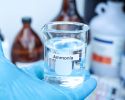Hydrogen to be cooled with seawater on Gotland ferries

The next generation of hydrogen-powered Gotland ferries will need to be filled with 16 tons of hydrogen for each round trip. The temperature in the ship's cylinders will rise far above the allowed limit if the hydrogen is not cooled. According to a new pre-study from Lighthouse, this can be achieved with seawater.
When a cylinder is filled with gas, the temperature rises as the pressure increases. Hydrogen also has the property that its temperature increases when it expands, which it will do when released from one tank to another with lower pressure.
"So, there are two effects that raise the temperature, which easily causes the hydrogen to exceed the allowed limit of 80°C in the cylinders. For roadtransportation, this has been solved by cooling the hydrogen to -40°C before refueling vehicles. But it's one thing to cool 50 kilograms of hydrogen compared to cooling the 16 tons needed to fill a ferry," says Björn Samuelsson, a researcher in quality engineering at Uppsala University, Campus Gotland.
How do you cool 16 tons of hydrogen? Cooling it before bunkering would require large amounts of energy and possibly a very expensive air separation plant. In the Large Scale Hydrogen Filling project, Björn Samuelsson and his colleagues have therefore had to think outside the box.
"What if we do the opposite and cool it after bunkering? Could we use active cooling with seawater flowing through a heat exchanger inside each cylinder on board the ship?"
Indeed, with 10-degree water, which is available year-round in Visby harbor, the temperature in the cylinders would end up somewhere between 40 and 60°C.
"You need a high flow rate of water, but the flow required is already fully possible today for cooling conventional engines," says Björn Samuelsson.
So far, the cylinder only works in theory, and the next step is to test it in reality. In a new research project funded by the Swedish Transport Administration, a downscaled prototype has been built, which will undergo safety testing during the spring before laboratory experiments are conducted with RISE in the autumn.
"If we get the same results as in our simulation model, things could progress quite quickly after that. In three to five years, the cylinder could be ready for the market. This is in line with the memorandum of understanding that Gotlandsbolaget has signed with an Australian shipyard for the fast catamaran Horizon X, which could be delivered as early as 2027.”
Even though the ferry can run on 100 percent green hydrogen, it won't be possible so early.
"There won't be enough hydrogen available in the ports, so most likely, they will first test delivering hydrogen with trailers to see how well the technology works. But just a few years later, perhaps around 2029, it might be possible to run entirely on hydrogen," says Björn Samuelsson.
The feasibility study Large Scale Hydrogen Filling has been conducted by Björn Samuelsson (project leader), Jim Allansson, and Kenneth Friberg from Uppsala University, as well as Kumail Marnate and Stefan Grönkvist from KTH. The work has been done in collaboration with Christer Bruzelius from Gotland Tech Development; Harald B Hansen from Hyon; Per Wimby from Stena Teknik, and Jens Berge from Norwegian Hydrogen.
-
 We are not approaching the transport policy goals
We are not approaching the transport policy goals -
 Time to pave the way for ammonia
Time to pave the way for ammonia -
 Norwegian officers skeptical of autonomous ships
Norwegian officers skeptical of autonomous ships -
 Drones and AI can save lives at sea
Drones and AI can save lives at sea -
 Watch the seminar Nordic Roadmap
Watch the seminar Nordic Roadmap -
 Research money yields manifold returns
Research money yields manifold returns -
 Bike counting at docks could save fuel
Bike counting at docks could save fuel -
 New rules needed for handling electric cars on board ships
New rules needed for handling electric cars on board ships -
 ChatGPT lacks spatial sense
ChatGPT lacks spatial sense -
 77 million SEK to the Sustainable Shipping Program
77 million SEK to the Sustainable Shipping Program

